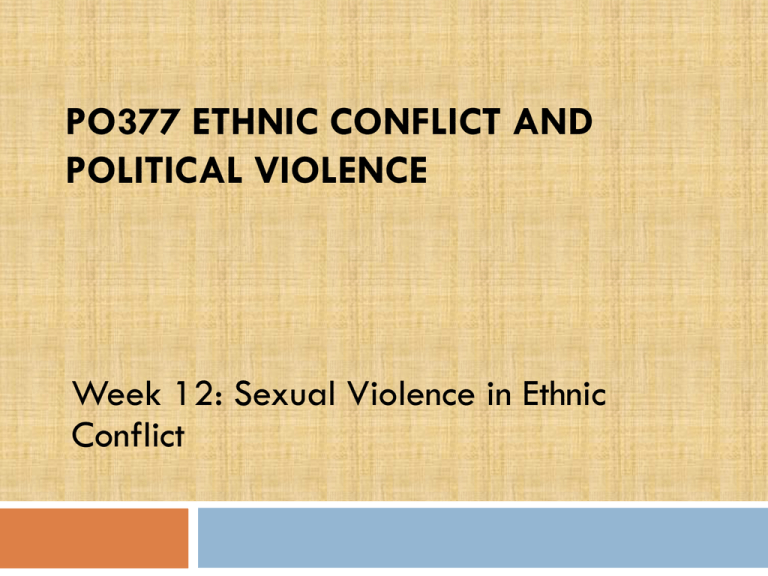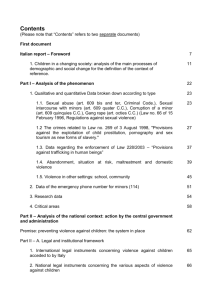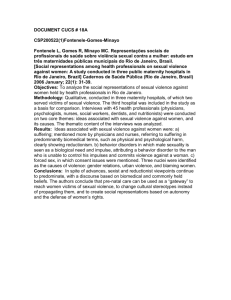
PO377 ETHNIC CONFLICT AND
POLITICAL VIOLENCE
Week 12: Sexual Violence in Ethnic
Conflict
Lecture Outline
Defining Sexual Violence
Issues with Defining Sexual Violence
Background
Theorising Sexual Violence in Ethnic Conflict
Essentialist explanations for sexual violence
Early feminist (essentialist??) explanations for sexual violence
Instrumentalist explanations for sexual violence
Constructivist explanations for sexual violence
Rape as the product of intersections between gender and ethnicity?
What about male victims?
Rwandan Case Study: Intersections between ethnicity and gender in sexual
violence
Wartime Sexual Violence and International Law
Summary
Defining Sexual Violence
Rape (involving some kind of penetration) is only one of several
forms of sexual violence.
The ICTR and ICTY define sexual violence as ‘any act of a
sexual nature which is committed on a person under
circumstances which are coercive ... not limited to physical
invasion of the human body, and may include acts which do not
involve penetration or even physical contact’.
Acts of sexual violence include rape, forced marriage, being
forced to parade naked, enforced prostitution, enforced
sterilisation, enforced impregnation, sexual mutilation, enforced
masturbation, forcing people to perform sexual acts on others,
and more.
Issues with Defining Sexual Violence
Despite the current international definition of sexual
violence (in the context of war), what is conceptualised
as sexual violence in local contexts is subject to
broader socio-cultural understandings.
Both men and women (and children) can become
victims and perpetrators of sexual violence, which is
acknowledged in international law, yet the dominant
presumption remains that men are not victims and
women are not perpetrators.
Background
Sexual violence features in almost every war but
until the early 1990s was very under-researched.
‘The rape of women in Bosnia-Herzegovina…
appeared unique because the rape of women in
history… has been rendered invisible.’ (Copelon
1995)
Increase in scale and brutality of wartime sexual
crimes in twentieth century and onwards?? (Open for
debate.)
Background (2)
Former Yugoslavia: estimated 20,000-50,000 women suffered
rape and other forms of SV during the wars 1991-1995;
further victims later in Kosovo. Forms of SV: mass rape; rape as
part of ‘ethnic cleansing’ of areas; rape in detention (rape
camps); forced impregnation; sexual torture; mutilation; forced
assaults on family members; SV against men and boys (numbers
unknown) as well as women and girls.
Rwanda: estimated 250,000-500,000 women and girls
suffered rape and other forms of SV during the genocide, the
vast majority Tutsi. Forms of SV: mass rape; sexual torture;
mutilation; forced ‘marriage’; deliberate HIV infection; SV as a
prelude to murder.
Background (3)
Sri Lanka: forms of SV: rape and other sexual assaults on Tamil
women and girls by police officers and by state soldiers; rape
and other sexual assaults on Tamil women and girls by
members of the Indian Peacekeeping Force; sexualised torture
in prison on Tamil men and boys as well as women and girls;
sexual assault or forced nakedness as a prelude to murder in
the final stages of the war. Most at risk: Tamil women believed
to be members of the LTTE or to be associated with male
members.
Northern Ireland: forms of SV: sexual harassment of local
(mainly Catholic) women by British soldiers; harassment and
assaults by police officers of women arrested for paramilitary
offences; degrading, violent and constant strip searches of
women imprisoned for paramilitary offences.
Theorising Sexual Violence in Ethnic Conflict
Reconsider the schools of thought we have discussed which
attempt to explain ethnic violence more generally:
Primordialism: ethnic violence is rooted in tensions between
different communities that result from fixed, ‘naturally’
predisposed group identities;
Instrumentalism: ethnic violence is contingent upon the behaviour
of political elites who instrumentalise ethnic features for their
own material interests;
Constructivism: both feelings of ethnic belonging and ethnic
violence are the outcome of social interactions and depend on
wider societal, political and economic circumstances.
Theorising Sexual Violence in Ethnic Conflict (2)
Essentialist Explanations for Sexual Violence
Similar to using primordialism when explaining the
causes of ethnic violence more generally, there is an
essentialist explanation for sexual violence in ethnic
conflict and other wars: the old (and contested) idea
that sexual violence follows from uncontrollable male
sexual desire and, following this, that sexual violence
(specifically rape) is one of the ‘spoils of war’ for
male soldiers, a reward for service.
BUT…
Theorising Sexual Violence in Ethnic Conflict (3)
Essentialist Explanations…
Psychological research shows that rape is a crime of power, not
of lust; a sexual manifestation of aggression, not an aggressive
manifestation of sexuality.
Biological research shows that the connection between the male
hormone (testosterone) and aggression is complex (Archer and
Lloyd 2002).
Rape of women as ‘spoils of war’, as reward: if rape is not
about sexual gratification this idea is problematic. Rape still
occurs in conflicts where prostitution is readily available.
Theorising Sexual Violence in Ethnic Conflict (4)
Early Feminist (Essentialist??) Explanations for Sexual
Violence
Ironically, some of the early second wave feminist analysis of
rape and sexual violence was so universalising that it had
essentialist overtones itself, though it was certainly concerned
with socialisation (and thus constructivism).
Example: Brownmiller (1976) argued that sexual violence
was motivated by a universal male tendency towards
indiscriminate violence against women and a masculine
desire to humiliate and maintain social control: ‘a conscious
process of intimidation by which all men keep all women in
a state of fear’.
Theorising Sexual Violence in Ethnic Conflict (5)
Early Feminist Explanations…
This analysis was also applied (then and later) to sexual violence
occurring in war:
‘Rape in war is a familiar act with a familiar excuse…. War
provides men with the perfect psychological backdrop to give
vent to their contempt for women’ (Brownmiller 1976, p. 32).
‘Rape… happens during war for the same reasons it happens
during peace. It is a phenomenon rooted in inequality,
discrimination, male domination and aggression, misogyny and
the entrenched socialization of sexual myths’ (Tompkins 1995).
BUT…
Theorising Sexual Violence in Ethnic Conflict (6)
Early Feminist Explanations…
Problems with the universal, indiscriminate male violence explanation for
wartime sexual violence (see Alison 2007):
1)
Not all men rape or commit acts of sexual violence;
2)
The extent of sexual violence in different societies and at different
times varies (culturally and socially determined);
3)
Men sometimes commit sexual violence against other men;
4)
There are cases of women committing or directing sexual violence;
5)
The intersection of gender with ethnicity is disregarded;
6)
This masks the complexities of wars and doesn’t account for wartime
variation (see E Wood 2006);
7)
Wartime sexual violence is rarely indiscriminate; it’s committed by
specific men against specific women (and men) and is often directed at
a military objective.
Theorising Sexual Violence in Ethnic Conflict (7)
Instrumentalist Explanations for Sexual Violence
Applying an instrumentalist explanation, sexual violence as a mass
phenomenon and/or a deliberate strategy is the outcome of the
manipulation of ethnic publics by political elites.
It is true that, in our case studies, political elites either publicly
encouraged (Rwanda and probably former Yugoslavia) or at the very
least ‘turned a blind eye’ (certainly in former Yugoslavia; arguably in Sri
Lanka and even Northern Ireland) to sexual violence.
However, this does not explain ‘why ethnic publics follow leaders down
paths that seem to serve elite power interests most of all’ (Fearon and
Laitin 2000). It also does not seem to explain all forms of wartime
sexual violence.
Theorising Sexual Violence in Ethnic Conflict (8)
Constructivist Explanations for Sexual Violence
According to constructivist explanations, wartime sexual
violence needs to be understood in the broader sociocultural framework in which it takes place (Skjelsbæk
2001).
With regard to sexual violence in ethnic conflict
specifically, we need to look at both gender power
imbalances and ethnic power imbalances, and how the two
intersect, to begin to see why and how sexual violence
occurs and the particular forms it takes (Alison 2007).
Theorising Sexual Violence in Ethnic Conflict (9)
Sexual violence as the product of intersections
between gender and ethnicity?
During conflict multiple binary constructions take on
heightened significance: ‘masculine’ vs. ‘feminine’ within a
group; ‘us’ vs. ‘them’ between groups; ‘our women’ vs. ‘their
women’; ‘our men’ vs. ‘their men’. ‘Our women’ = chaste,
honourable, to be protected; ‘their women’ = unchaste and
depraved, deserving degradation.
Militarized nationalism ‘does not simply allow men to be
violent, but compels them so to be. In militarized
societies… men who resist violence are suspect. Not only is
their loyalty to the state [or nation] questioned, but also
their loyalty to (heterosexual) masculinity’ (Price 2001).
Theorising Sexual Violence in Ethnic Conflict (10)
Intersections between gender and ethnicity…
‘Enemy’ women are targeted for sexual violence because of women’s
importance in constructing and maintaining the ethno-national group.
Roles as biological and cultural reproducers, signifiers of ethnonational difference etc. mean they’re targets in attempts to dominate
or destroy a collectivity. The female body is ‘a symbolic
representation of the body politic’; rape of women is ‘the symbolic
rape of the body of [the] community’ (Seifert 1994). [Think about the
gender and nationalism literature.]
Wartime sexual violence as communication between men; a way to
emasculate the male enemy through their failure to protect ‘their’
women. Also communication from men to women (that they are
powerless objects of contempt) (Tompkins 1995).
Theorising Sexual Violence in Ethnic Conflict (11)
What about male victims?
Male to male wartime sexual violence is no less gendered or
ethnicized than male to female violence; it is still about asserting
power and masculinity (Alison 2007).
A victim of wartime sexual violence (female or male) ‘is victimized by
feminizing both the sex and the ethnic/religious/political identity to
which the victim belongs, likewise the perpetrator’s sex and
ethnic/religious/political identity is empowered by becoming
masculinized’ (Skjelsbæk 2001). (The soldier-rapist asserts his
‘hetero-nationality’ (Hague 1997).)
HOWEVER, patterns/forms of wartime sexual violence against men
seem to be different from those against women. Think about sexual
violence against men during the wars in the former Yugoslavia. What
does this make us consider?
Rwandan Case Study: Intersections between
ethnicity and gender in sexual violence
Genocidal anti-Tutsi campaign: manipulation of constructions of
gender as well as ethnicity. Gender issues ‘figured prominently
in the social construction of boundaries between ethnic groups
and in local cultural notions of racial purity’ (Taylor 1999).
Demonization of Tutsi women as oversexualized, dangerous,
arrogant, enemies of the state. Legacy of colonial ideas:
ideology of ‘Hamitism’. Contributed to sexual violence against
Tutsis.
1990 ‘Hutu Ten Commandments’ included directives relating to
prohibiting fraternisation with Tutsi women.
Hutu women were involved in directing and participating in
genocide and in directing and inciting sexual violence against
Tutsi women.
Wartime Sexual Violence and International Law
1949 Geneva Conventions and 1977 Additional Protocols:
sexual violence not a ‘grave breach’ but a lesser abuse.
Geneva Conventions characterise sexual violence as an attack
against women’s ‘honour’ rather than as a violent crime that
violates bodily integrity. See UN Division for the Advancement
of Women (April 1998):
http://www.un.org/womenwatch/daw/public/w2apr98.htm
1974 UN Declaration on the Protection of Women and Children
in Emergencies and Armed Conflicts; 1979 Convention on the
Elimination of All Forms of Discrimination against Women.
Neither mention sexual violence. By the mid-1990s, all forms of
violence against women were on the feminist human rights
activist agenda.
Wartime Sexual Violence and International Law (2)
Important developments followed the wars in the former
Yugoslavia and Rwanda:
1994: UN Human Rights Commission established a Special
Rapporteur on violence against women.
1994: UN Declaration on the Elimination of Violence against
Women addressed sexual violence but not in the context of
war.
1995: Sub-commission on the Prevention of Discrimination and
the Protection of Minorities established a Special Rapporteur
on the situation of systematic rape, sexual slavery and slaverylike practices during periods of armed conflict.
Wartime Sexual Violence and International Law (3)
ICTY recognized and tried sexual violence for first time as a distinct war
crime and as a crime against humanity (http://www.un.org/icty/).
ICTR recognized rape for first time as potentially an act of genocide,
under Article II(b) in Genocide Convention which included in definition of
genocidal acts those causing ‘serious bodily or mental harm to members
of the group’ (http://unictr.org/default.htm).
Rome Statute of the International Criminal Court also recognizes sexual
violence (including forced pregnancy) as a war crime and a crime
against humanity.
UN Security Council Resolution 1820 (2008) demands action to end
wartime sexual violence (http://daccess-ddsny.un.org/doc/UNDOC/GEN/N08/391/44/PDF/N0839144.pdf?Ope
nElement); this alternates between gender neutral language (allowing
for male victims), and explicit references to protection of women and
girls.
Summary
The aim of sexual violence against women of the ‘Other’ ethnic group
can be to rip apart the fabric of society. Remembering the significance
of women’s actual and symbolic roles in ethnic groups and nationalist
ideologies it is clear why this is such an effective strategy.
Men are also sometimes subjected to sexual violence, designed to
humiliate (feminize) the man, his masculinity and the masculinity of his
ethno-national group.
The explanatory power of essentialist and instrumentalist arguments
about sexual violence in ethnic conflict is limited. Constructivist
explanations that address socio-cultural context and the intersections
between gender and ethnicity are more productive.
Summary (2)
Arguments based solely on sexual violence as a product of
universal patriarchal gender relations do not explain why in
ethnic wars this is often targeted at women of opposing ethnic
groups, not at all women indiscriminately. They also fail to
explain the (less frequent) sexual violence against men.
But to argue sexual violence is simply one abuse of many
committed to demoralise the enemy group does not explain
why sexual violence is usually or more commonly directed at
women rather than men, or why the forms it takes are different
depending on whether the victims are female or male. We
need an analytical approach that takes account of both gender
and ethnicity.








